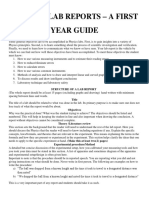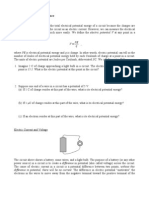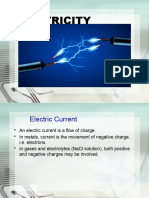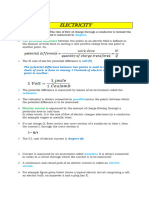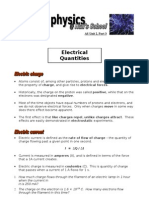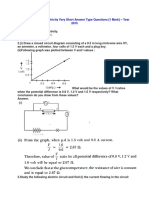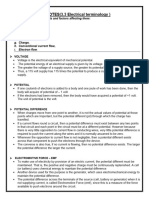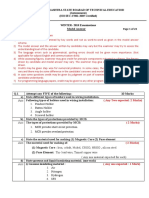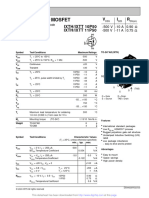0 ratings0% found this document useful (0 votes)
57 viewsElectricity: Solution of Intext Questions (NCERT Book) Part:-1
Electricity: Solution of Intext Questions (NCERT Book) Part:-1
Uploaded by
jots2This document contains solutions to textbook questions about electricity. It defines electric current as the flow of electric charge carried by moving electrons. The unit of current is defined as the ampere, which is equal to one coulomb of charge passing through a surface per second. Resistance of a conductor depends on its material, length, and cross-sectional area. Thicker wires have lower resistance and allow more current to flow than thinner wires of the same material. If potential difference decreases but resistance stays the same, current will also decrease proportionally. Alloys are used in electric heaters instead of pure metals because they have higher melting points.
Copyright:
© All Rights Reserved
Available Formats
Download as DOC, PDF, TXT or read online from Scribd
Electricity: Solution of Intext Questions (NCERT Book) Part:-1
Electricity: Solution of Intext Questions (NCERT Book) Part:-1
Uploaded by
jots20 ratings0% found this document useful (0 votes)
57 views4 pagesThis document contains solutions to textbook questions about electricity. It defines electric current as the flow of electric charge carried by moving electrons. The unit of current is defined as the ampere, which is equal to one coulomb of charge passing through a surface per second. Resistance of a conductor depends on its material, length, and cross-sectional area. Thicker wires have lower resistance and allow more current to flow than thinner wires of the same material. If potential difference decreases but resistance stays the same, current will also decrease proportionally. Alloys are used in electric heaters instead of pure metals because they have higher melting points.
Original Description:
Solution of Intext Questions (NCERT Book)Part :- 1
Original Title
Electricity
Copyright
© © All Rights Reserved
Available Formats
DOC, PDF, TXT or read online from Scribd
Share this document
Did you find this document useful?
Is this content inappropriate?
This document contains solutions to textbook questions about electricity. It defines electric current as the flow of electric charge carried by moving electrons. The unit of current is defined as the ampere, which is equal to one coulomb of charge passing through a surface per second. Resistance of a conductor depends on its material, length, and cross-sectional area. Thicker wires have lower resistance and allow more current to flow than thinner wires of the same material. If potential difference decreases but resistance stays the same, current will also decrease proportionally. Alloys are used in electric heaters instead of pure metals because they have higher melting points.
Copyright:
© All Rights Reserved
Available Formats
Download as DOC, PDF, TXT or read online from Scribd
Download as doc, pdf, or txt
0 ratings0% found this document useful (0 votes)
57 views4 pagesElectricity: Solution of Intext Questions (NCERT Book) Part:-1
Electricity: Solution of Intext Questions (NCERT Book) Part:-1
Uploaded by
jots2This document contains solutions to textbook questions about electricity. It defines electric current as the flow of electric charge carried by moving electrons. The unit of current is defined as the ampere, which is equal to one coulomb of charge passing through a surface per second. Resistance of a conductor depends on its material, length, and cross-sectional area. Thicker wires have lower resistance and allow more current to flow than thinner wires of the same material. If potential difference decreases but resistance stays the same, current will also decrease proportionally. Alloys are used in electric heaters instead of pure metals because they have higher melting points.
Copyright:
© All Rights Reserved
Available Formats
Download as DOC, PDF, TXT or read online from Scribd
Download as doc, pdf, or txt
You are on page 1of 4
Electricity
Solution of Intext Questions (NCERT Book)Part :- 1
Question: 1. What does an electric current mean?
Answer:- The flow of electric charge is known as electric current. Electric current
is carried by moing electrons through a conductor. Electric current flows in
o!!osite direction to the moement of electrons.
Question: "- #efine the unit of current.
Answer:- $% unit of electric current is am!ere &A'.
Am!ere is the flow of electric charges through a surface at the rate of one
coulomb !er second( i.e. if 1 coulomb of electric charge flows through a cross
section for 1 second( it would be e)ual to 1 am!ere.
Question: * - +alculate the number of electrons constituting one coulomb of
charge.
Answer:-
Question: , - -ame a deice that hel!s to maintain a !otential difference across
a conductor.
Answer:- .attery or a cell
Question: /. What is meant by saying that the !otential difference between two
!oints is 1 0?
Answer: This means 1 1oule of work is done to moe a charge of 1 coulomb
between two !oints.
Question: 2. 3ow much energy is gien to each coulomb of charge !assing
through a 2 0 battery?
Answer:
4ien( +harge Q 5 1+( 6otential difference( 0 5 20
Therefore( Energy i.e. Work done( W 5?
Question: 7 - 8n what factors does the resistance of a conductor de!end?
Answer: 9esistance of a conductor de!ends u!on:
&a' -ature of conductor
&b' :ength of conductor
&c' Area of cross section of conductor
Question: ;. Will current flow more easily through a thick wire or a thin wire of the
same material( when connected to the same source? Why?
Answer: $ince( resistance is indirectly !ro!ortional to the area of cross section(
thus current flows easily through a thick wire com!ared to a thin wire of the same
material.
Question: <. :et the resistance of an electrical com!onent remain constant while
the !otential difference across the two ends of the com!onent decreases to half
of its former alue. What change will occur in the current through it?
Answer:
Therefore( if !otential difference between two ends of the com!onent will be
haled( and resistance remains constant( then electric current would also be
haled.
Question: 1=. Why are coils of electric toasters and electric irons made of an
alloy rather than a !ure metal?
Answer: $ince( alloys hae higher melting !oint than !ure metal so coils of
electric toasters and electric irons are made of an alloy rather than a !ure metal
to retain more heat without melting.
Question: 11. >se the data in Table 1"." to answer the following ?
&a' Which among iron and mercury is a better conductor?
Answer: %ron
&b' Which material is the best conductor?
Answer: $iler
Question: 1". #raw a schematic diagram of a circuit consisting of a battery of
three cells of " 0 each( a / @ resistor( an ; @ resistor( and a 1" @ resistor( and a
!lug key( all connected in series.
Answer:
Question: 1*. 9edraw the circuit of Question 1( !utting in an ammeter to measure
the current through the resistors and a oltmeter to measure the !otential
difference across the 1" @ resistor. What would be the readings in the ammeter
and the oltmeter?
Answer:
The total resistance in the circuit 5 $um of the resistances of all resistors
5 / @ A ; @ A 1" @ 5 "/ @
We knowB
$ince( resistances are connected in series( thus electric current remains the
same through all resistors.
3ere we hae(
Electric current( % 5 =.",A
9esistance( 9 5 1"@
Thus( !otential difference( 0 through the resistor of 1"@ 5 % C 9
8r( 0 5 =.",A C 1"@ 5 ".;; 0
Thus( reading of ammeter 5 =.",A
9eading of oltmeter through resistor of 1"@ 5 ".;;0
You might also like
- Physics 1 and Physic 2 SPH 2170 and 2171Document35 pagesPhysics 1 and Physic 2 SPH 2170 and 2171patrickNo ratings yet
- Toyota 5FDocument51 pagesToyota 5FAli Abs0% (1)
- Electricity Class X NotesDocument15 pagesElectricity Class X NotesGrgg Hkhkk100% (5)
- 10th Electricity Study Notes For Chapter - 12 Ncert PDFDocument11 pages10th Electricity Study Notes For Chapter - 12 Ncert PDFNaseeb YadavNo ratings yet
- 10 Chapter-12-: Electricity CBSE Study NotesDocument11 pages10 Chapter-12-: Electricity CBSE Study Notesrucha BNo ratings yet
- Voltage and ResistanceDocument4 pagesVoltage and ResistanceMark ProchaskaNo ratings yet
- ElectricityDocument2 pagesElectricityAJITHKUMARNo ratings yet
- Electricity - Part 1Document9 pagesElectricity - Part 1Saji JayarajNo ratings yet
- Current Electricity .Document8 pagesCurrent Electricity .majjicharanteja2006No ratings yet
- Electricity Numerical StudyPhobia ExclusiveDocument39 pagesElectricity Numerical StudyPhobia ExclusiveYtnew SubNo ratings yet
- Electricity Class 9 MCQs DefinitionsDocument4 pagesElectricity Class 9 MCQs Definitionssk0822838No ratings yet
- Electricity: Electric CurrentDocument10 pagesElectricity: Electric CurrentTajiriMollelNo ratings yet
- works - CopyDocument3 pagesworks - Copyshreya.1q.09No ratings yet
- Ee 312Document6 pagesEe 312anon_936382570No ratings yet
- Work Sheet 2 ResistorsDocument7 pagesWork Sheet 2 Resistorskanchan.solnkee15No ratings yet
- Class-10 Electrycity MCQDocument10 pagesClass-10 Electrycity MCQNuman KhanNo ratings yet
- NCERT Solutions For Class 10 Science Chapter 12 ElectricityDocument29 pagesNCERT Solutions For Class 10 Science Chapter 12 ElectricityManwinder Singh GillNo ratings yet
- Chapter 12: Electricity: 1 Ampere 1 Coulomb / SecondDocument11 pagesChapter 12: Electricity: 1 Ampere 1 Coulomb / SecondVikash SharmaNo ratings yet
- ElectricityDocument44 pagesElectricityKirancivilNo ratings yet
- Lecture 5 Moving Charges LCDocument82 pagesLecture 5 Moving Charges LCCowboy XxNo ratings yet
- Electric Circuits, Resistance & Ohm's Law: AnswerDocument60 pagesElectric Circuits, Resistance & Ohm's Law: Answerdhanukrishnag0% (1)
- Electric CurrentDocument38 pagesElectric CurrentChelsie Fae SantosNo ratings yet
- Electricity Physics NotesDocument17 pagesElectricity Physics NotesbhagyavathinrhoneyNo ratings yet
- 2024-2025-Class X-Physics-Chapter 3-AWDocument19 pages2024-2025-Class X-Physics-Chapter 3-AWInaaya KhanNo ratings yet
- Resistance and Conductance: E.M.F Can Be Defined AsDocument5 pagesResistance and Conductance: E.M.F Can Be Defined AsBubacarr ChamNo ratings yet
- El 2Document27 pagesEl 2ashok pradhanNo ratings yet
- Ans Electricity Additional Questions 1Document5 pagesAns Electricity Additional Questions 1Rohit JindalNo ratings yet
- Electricity Study Material & NCERT SolutionsDocument47 pagesElectricity Study Material & NCERT Solutionsyashvi0123456789No ratings yet
- Physics XII CH 3 CASE STUDY Current ElectricityDocument22 pagesPhysics XII CH 3 CASE STUDY Current ElectricityNjan KL16么Porotta0% (1)
- Lesson 1 - Circuits 1Document19 pagesLesson 1 - Circuits 1mynameisjustinemontillaNo ratings yet
- Lesson 28 Electric CurrentDocument7 pagesLesson 28 Electric Currenti5piritiNo ratings yet
- Current, Resistance and EMF - DONEDocument7 pagesCurrent, Resistance and EMF - DONEcindy boysilloNo ratings yet
- Current ElectricityDocument85 pagesCurrent Electricityanus3jan2007No ratings yet
- Class 10 Science Electricity Short Answer Type QuestionsDocument39 pagesClass 10 Science Electricity Short Answer Type QuestionsLawrence GaikwadNo ratings yet
- Question Bank Current Electricity CBSEDocument9 pagesQuestion Bank Current Electricity CBSEjashankalsi811No ratings yet
- Electricity Chapter Wise Important Questions Class 10 ScienceDocument32 pagesElectricity Chapter Wise Important Questions Class 10 SciencemarkNo ratings yet
- Topic 11 Electric CurrentDocument27 pagesTopic 11 Electric Currentalonce13.31No ratings yet
- Current of Electricity and DC CircuitsDocument14 pagesCurrent of Electricity and DC CircuitsZhao Le TongNo ratings yet
- N10. Electrical QuantitiesDocument11 pagesN10. Electrical QuantitiesAwais FarooqiNo ratings yet
- Electric Current: The Electric Current Is A Stream of Moving ChargesDocument10 pagesElectric Current: The Electric Current Is A Stream of Moving ChargesOzNaveeNo ratings yet
- 3.2 Electric CurrentDocument36 pages3.2 Electric CurrenttaufiqstuneNo ratings yet
- Electricity Chapter Wise Important Questions Class 10 Science Learn CBSEDocument39 pagesElectricity Chapter Wise Important Questions Class 10 Science Learn CBSELushila MinjNo ratings yet
- Electricity Chapter Wise Important Questions Class 10 Science - Learn CBSEDocument39 pagesElectricity Chapter Wise Important Questions Class 10 Science - Learn CBSEAmitChopra100% (2)
- Electricity: Circuit Symbols - You Met These Circuit Symbols in GCSE PhysicsDocument22 pagesElectricity: Circuit Symbols - You Met These Circuit Symbols in GCSE PhysicsBaberBegNo ratings yet
- Physics 28 - Electrical Quantities 2Document65 pagesPhysics 28 - Electrical Quantities 2Mohammed Basit100% (1)
- Current EelctricityDocument26 pagesCurrent Eelctricitycprakash416No ratings yet
- Class 10 Science Electricity Short Answer Type QuestionsDocument42 pagesClass 10 Science Electricity Short Answer Type QuestionsShardul SumantNo ratings yet
- Current Electricity Important 10 Year QuestionsDocument28 pagesCurrent Electricity Important 10 Year Questionshimanshu.002tNo ratings yet
- Lesson: ElectricityDocument13 pagesLesson: Electricitybudesasaiaw.v.re32.90No ratings yet
- 3.3 Electrical TerminologyDocument3 pages3.3 Electrical TerminologyArun RajeevNo ratings yet
- Electricity - CLASS XDocument90 pagesElectricity - CLASS XSarathrv RvNo ratings yet
- DC Circuits FinalDocument44 pagesDC Circuits FinalSilver ShadesNo ratings yet
- XII-CURRENT ELECTRICITY WSDocument9 pagesXII-CURRENT ELECTRICITY WSvenkateshk3022No ratings yet
- GR Bee PPTS Unit - I To IvDocument205 pagesGR Bee PPTS Unit - I To IvSri HarshaNo ratings yet
- Basic ElectricityDocument19 pagesBasic ElectricityTerfaia NadjatNo ratings yet
- Current Electricity Holiday AssignmentDocument9 pagesCurrent Electricity Holiday AssignmentmonchériNo ratings yet
- Current Electricity Imp QuesDocument77 pagesCurrent Electricity Imp QuesAashish kpNo ratings yet
- EletricityDocument14 pagesEletricitynoahin26No ratings yet
- TEST ANSWERS (First Week) Chapter No 1.1 (GG)Document2 pagesTEST ANSWERS (First Week) Chapter No 1.1 (GG)GAGANNo ratings yet
- General Physics 2 Current, Resistivity, and ResistanceDocument36 pagesGeneral Physics 2 Current, Resistivity, and ResistanceDharyl Ballarta100% (3)
- CH 03Document31 pagesCH 03AMAAN FIRDAUSINo ratings yet
- Complete Electronics Self-Teaching Guide with ProjectsFrom EverandComplete Electronics Self-Teaching Guide with ProjectsRating: 3 out of 5 stars3/5 (2)
- 12 - 70 MB Wali Ka Fundamentals of Physics - Jearl Walker Pass-6 Physics Principles and Problems Pass Is 1Document1 page12 - 70 MB Wali Ka Fundamentals of Physics - Jearl Walker Pass-6 Physics Principles and Problems Pass Is 1jots2No ratings yet
- 12 - 70 MB Wali Ka Fundamentals of Physics - Jearl Walker Pass-6Document1 page12 - 70 MB Wali Ka Fundamentals of Physics - Jearl Walker Pass-6jots2No ratings yet
- 12 - 70 MB Wali Ka Fundamentals of Physics - Jearl Walker Pass-6 Physics Principles and Problems Pass Is 1Document1 page12 - 70 MB Wali Ka Fundamentals of Physics - Jearl Walker Pass-6 Physics Principles and Problems Pass Is 1jots2No ratings yet
- I 12 - 70 MB Wali Ka Fundamentals of Physics - Jearl Walker Pass-6 Physics Principles and Problems Pass Is 1Document1 pageI 12 - 70 MB Wali Ka Fundamentals of Physics - Jearl Walker Pass-6 Physics Principles and Problems Pass Is 1jots2No ratings yet
- 12 - 70 MB Wali Ka Fundamentals of Physics - Jearl Walker Pass-6 Physics Principles and Problems Pass Is 1Document1 page12 - 70 MB Wali Ka Fundamentals of Physics - Jearl Walker Pass-6 Physics Principles and Problems Pass Is 1jots2No ratings yet
- 12 - 70 MB Wali KaDocument1 page12 - 70 MB Wali Kajots2No ratings yet
- Force Is The Muliply of Mass and AccelerationDocument1 pageForce Is The Muliply of Mass and Accelerationjots2No ratings yet
- AbDocument1 pageAbjots2No ratings yet
- FGSGFGDFG DFFGDGFGFDG Dafgdfg DFFGDFG DFGDF GDFG DF Gdaf GD G Tfger Tre TGR TGT Hyhj J G DFGDF FJ Yttg DFH DT DFGDF J HG H GH JDocument1 pageFGSGFGDFG DFFGDGFGFDG Dafgdfg DFFGDFG DFGDF GDFG DF Gdaf GD G Tfger Tre TGR TGT Hyhj J G DFGDF FJ Yttg DFH DT DFGDF J HG H GH Jjots2No ratings yet
- Capacitance of A ConductorDocument1 pageCapacitance of A Conductorjots2No ratings yet
- EE 075 - Electrical Circuits and Sensors Lab 1 - Breadboards and ResistanceDocument11 pagesEE 075 - Electrical Circuits and Sensors Lab 1 - Breadboards and ResistanceKatie AhoNo ratings yet
- ExamdostDocument28 pagesExamdostChintuSagarNo ratings yet
- Intro TO Cable TestingDocument21 pagesIntro TO Cable TestingFahdAhmed100% (1)
- Specification of TransformerDocument43 pagesSpecification of TransformerJaaffer AliNo ratings yet
- Presentation 10 Types of Electrical Measuring Instruments and TheirDocument15 pagesPresentation 10 Types of Electrical Measuring Instruments and Theirmarica DolorNo ratings yet
- CSE - 33 Touch Voltage Measurements New Approach For Measurements On Lines in ServiceDocument16 pagesCSE - 33 Touch Voltage Measurements New Approach For Measurements On Lines in ServicebenlahnecheNo ratings yet
- Section-GTR, Revision-14 - TS of RTV Coating - Annexure H - Rev 1Document5 pagesSection-GTR, Revision-14 - TS of RTV Coating - Annexure H - Rev 1shaswatNo ratings yet
- 22328Document23 pages22328Harshal VaidyaNo ratings yet
- Standard Power MOSFET: V I R IXTH/IXTT 10P50 IXTH/IXTT 11P50Document4 pagesStandard Power MOSFET: V I R IXTH/IXTT 10P50 IXTH/IXTT 11P50ISMAIL ELECTRNo ratings yet
- Eee1001 - Electrical Circuits and Systems: Abhishek JoshiDocument41 pagesEee1001 - Electrical Circuits and Systems: Abhishek JoshiDIPTANU SAHANo ratings yet
- Vacon NX Brake ResistorDocument26 pagesVacon NX Brake Resistorpesho100% (1)
- Basics of Electricity For AnaesthetistsDocument5 pagesBasics of Electricity For AnaesthetistsClaire PollingtonNo ratings yet
- DatasheetDocument8 pagesDatasheetTom TomNo ratings yet
- Description TestDocument104 pagesDescription TestRaniel NecesitoNo ratings yet
- 32 Bfe 512 FC 8450942 CDocument5 pages32 Bfe 512 FC 8450942 CDoktor transmisionesNo ratings yet
- Datasheet Techman OMIT SS 124LMDocument2 pagesDatasheet Techman OMIT SS 124LMSteve MurphyNo ratings yet
- CM Ti9000-Eng-Tech-Info-CatalogueDocument32 pagesCM Ti9000-Eng-Tech-Info-CatalogueJial FigueroaNo ratings yet
- Distance Protection: Earth-Faults and Fault Resistance: Power Transmission and DistributionDocument20 pagesDistance Protection: Earth-Faults and Fault Resistance: Power Transmission and DistributionAhlam DaasNo ratings yet
- IIT JEE Physics QuestionsDocument11 pagesIIT JEE Physics QuestionsKartikNo ratings yet
- Temperatue and DiplacementDocument63 pagesTemperatue and Diplacementaregawi weleabezgi100% (1)
- Military Handbook Grounding, Bonding, and Shielding For Electronic Equipments and Facilities Volume 1 of 2 Volumes - Basic TheoryDocument812 pagesMilitary Handbook Grounding, Bonding, and Shielding For Electronic Equipments and Facilities Volume 1 of 2 Volumes - Basic Theorybal3xNo ratings yet
- Manual ACM36 (Position Encoder) PDFDocument16 pagesManual ACM36 (Position Encoder) PDFWahyu TryNo ratings yet
- Physics Practical Index Dates (24-25)Document2 pagesPhysics Practical Index Dates (24-25)HALOLLOLNo ratings yet
- V-I Characteristics OF PN Junction DiodeDocument5 pagesV-I Characteristics OF PN Junction DiodeSIVARAMJINo ratings yet
- Project 2 PDFDocument127 pagesProject 2 PDFHassan AliNo ratings yet
- Stressanalysis - 1 4 Bridge Calibration PDFDocument6 pagesStressanalysis - 1 4 Bridge Calibration PDFGilbertoAndresDuarteNo ratings yet
- GaAs OhmicContact Receita PDFDocument5 pagesGaAs OhmicContact Receita PDFKadu BritoNo ratings yet
- Course Name: Basic Electronics: B.Tech First YearDocument25 pagesCourse Name: Basic Electronics: B.Tech First YearNeha GabaNo ratings yet
